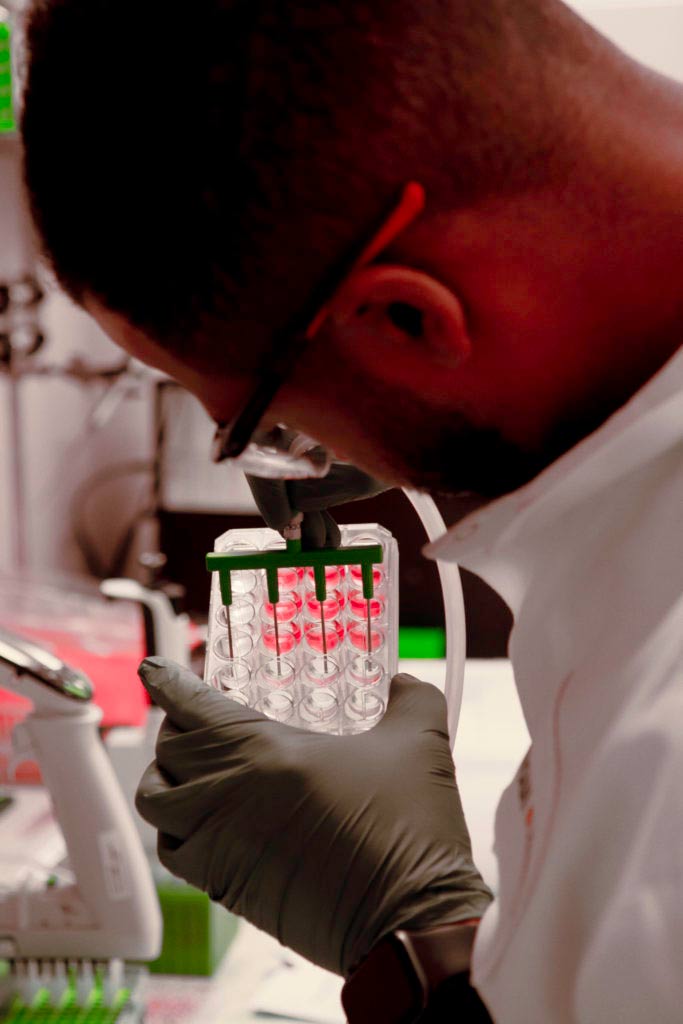

DDI & Drug Repurposing Article featured in Drug Discovery World (DDW) Spring Edition 2021
- Drug Drug Interactions (DDI)
- April 29, 2021
- Madison Esely-Kohlman, Dr. Brian Ogilvie
“The role of in vitro drug interaction data as a critical element in drug repurposing” by Madison (Knapp) Esely-Kohlman and Dr. Brian Ogilvie was reprinted in the Spring 2021 issue of Drug Discovery World (DDW), page 48
As of November 2020, 696 drug candidates fill the drug development pipeline for a single disease indication—COVID-19, driven by a coronavirus known as SARS-CoV-2.1 How are so many hopefuls already in line, less than a year after the virus arose, when a new chemical entity typically takes multiple years and sometimes up to billions of dollars to be developed?
The answer lies in a common practice that has been saving drug developers precious time and money by allowing them to take an existing de-risked compound and apply it to a new indication. Repurposing (repositioning, re-profiling, or re-tasking) a drug potentially saves years of costly testing from going to waste and potentially providing a higher chance of success. “Perhaps most importantly, the risk of failure is lower […] because the repurposed drug has already been found to be sufficiently safe in preclinical models and humans if early-stage trials have been completed, it is less likely to fail at least from a safety point of view in subsequent efficacy trials.”2
Many drugs on the market today were originally developed for something different than what they currently treat. For example, the widely-prescribed attention-deficit/hyperactivity disorder (ADHD) medication Strattera (atomoxetine) went through the development pipeline first as a selective norepinephrine reuptake inhibitor (SNRI) to treat depression and Parkinson disease. In clinical trials, however, research concluded that “Atomoxetine treatment was not efficacious for the treatment of clinically significant depressive symptoms in PD, but was associated with improvement in global cognitive performance and daytime sleepiness.”3 Instead of accepting defeat as a failed anti-depressant, atomoxetine re-entered the ring—this time for attention-deficit disorder—and found enormous success as the first ever nonstimulant medication for ADHD. Other repurposed drug success stories include Viagra (sildenafil, originally developed to treat hypertension and angina), aspirin, thalidomide, and many more.
Regulatory authorities are making it easier for there to be more success stories like these. Current regulatory policies encourage pharmaceutical companies to consider this option where possible; in their 2017 presentation, “Yes, you can teach an old drug new tricks: Regulatory Pathway for Repurposed Drugs,” the FDA highlights the advantages to re-tasking, citing risk mitigation, speedy market entry, and reduced cost.4 They particularly emphasize patient need, especially in cases of rare and neglected diseases and conditions, which may be addressed by medications already in circulation.
Pivoting an existing, approved drug for a new indication is not the only way to find success in the realm of repurposed drugs. There is a huge pharmacopoeia of drugs which have failed due to lack of efficacy, but usually this attrition occurs only after a full complement of preclinical safety testing which shows that a drug will be safe for administration to humans. If a sponsor elects to take one of these failed drugs off the shelf for repurposing, efficacy for the previous indication is often irrelevant so the drug is no longer a failure but rather a safe drug that hasn’t yet been tested for efficacy against the new indication. This gives the drug developer a huge leg up because they can forego a lot of the preclinical work a new chemical entity would require.
However, it’s not a sure and immediate transition from identifying a potentially effective candidate to clinical testing. Before a data package is submitted for regulatory approval to engage in clinical phases, a careful and thorough examination of existing data is necessary to ensure risk assessments and safety data is able to withstand current regulatory scrutiny—even if the drug was previously approved for market.

The world of drug safety is constantly growing, learning, and evolving, so there are checkboxes that drug developers must consider now that may not have been on the list even five years ago. This is especially true for evaluation areas such as drug-drug interaction (DDI) risk, where there have been recent guidance updates to reflect latest scientific consensus. This review process as part of drug repurposing can be complex and requires familiarity with updated guidance, how it may have changed since the drug was originally approved for IND, and expertise in using all available testing and data to understand a compound’s risk profile.
Reviewing Preexisting Data: Gap Analysis
In many cases, such as rare diseases or sudden outbreaks, the need for a treatment necessitates fast-tracking a compound through development checkpoints to get to clinical phases as quickly as possible. In these instances it’s especially important to remember that urgency must not come at the sacrifice of due diligence. In repurposing drugs for a new indication, a critical part of the process is to review all available data about the drug’s safety and make sure there are no missing pieces, or ‘gaps’, which could cause safety issues for clinical trial volunteers or patients down the road.
Gap analysis, with the assistance of an expert or team of scientists intimately familiar with drug-drug interaction studies from a regulatory and a scientific perspective, can prove invaluable for repurposing drugs. It helps paint an accurate picture of risk for a sponsor that could inform crucial decisions in the clinic and explain results that would otherwise cause roadblocks for getting through clinical stages. As a CRO specializing in helping sponsors take a close look at drug metabolism and DDI potential, we have provided studies or consultation for a variety of the 69 compounds mentioned in the 2020 Nature publication, “A SARS-CoV-2 protein interaction map reveals targets for drug repurposing,”5 to patch holes in existing data to meet current regulatory expectations.
Our team of expert consultants have extensive experience working on IND-enabling DDI data packages for new drugs, and that expertise can be easily repurposed itself for clients pursuing the 505(b)(2) regulatory pathway. The 505(b)(2) pathway is an efficient avenue for pharmaceutical companies seeking reintroduction of their drug in a new dose or form, label expansion, or to repurpose drugs already in the market for new indications. Sponsors may supply previously conducted studies and safety data in support of a New Drug Application (NDA), but that data must stand up to current standards. At this stage, our DDI consulting experts can assist clients to examine drug interaction data piece by piece to ensure data meet current regulatory expectations and sniff out any potential DDI issues prior to the clinic.
“Oftentimes we work with clients who have a lot of great data but if the in vitro DDI data are 20 years old, it could prove more difficult than you’d think to square old data with where scholarship and regulatory expectations are now,” explains Dr. Brian Ogilvie, Vice President of Scientific Consulting at XenoTech. “You have to have a lot of experience with DDI work specifically to elucidate potential roadblocks and formulate a solid plan to smooth out the edges of the data package and make sure it will be defensible and ultimately accepted. One of the worst things that could happen is you breeze through old safety studies without a second look and end up with restrictive exclusion criteria in Phase II or III clinical protocols due to a lack of in vitro transporter or other DDI studies.”
Re-evaluating Your Drug’s Risk of DDI
The best approach drug developers can use to anticipate potential drug-drug interaction issues in the clinic is through nonclinical in vitro DDI studies to experimentally determine a drug’s perpetrator or victim potential in a transporter- or metabolism-mediated DDI. Sufficient in vitro DDI investigation prevents unnecessary exclusion of patients from clinical trials and informs clinical DDI study design if appropriate. In repurposing a drug, the developer may already have DDI data but revisiting old studies in light of guidance updates or new testing standards is key to appropriate DDI risk assessment, meaning regulators and drug developers alike can be more confident in the safety of potential therapies.
As a CRO specializing in helping drug developers identify DDI potential of their new or repurposed compound, we offer many products and services to give our clients the most high-value data on which to base assessment and decisions. These offerings are specifically designed to satisfy recommendations from regulatory agencies calling for thorough investigation of DDI risk of Investigational New Drugs:
Evaluating the DDI potential of an investigational new drug involves: (1) identifying the principal routes of the drug’s elimination; (2) estimating the contribution of enzymes and transporters to the drug’s disposition; and (3) characterizing the effect of the drug on enzymes and transporters. This evaluation often starts with in vitro experiments to identify potential factors influencing drug disposition to elucidate potential DDI mechanisms and to yield kinetic parameters for use in further studies. Results of in vitro experiments, along with clinical pharmacokinetic (PK) data, provide mechanistic information that can inform the need for and proper design of potential future clinical studies.
US FDA, Final Guidance “In Vitro Drug Interaction Studies—Cytochrome P450 Enzyme- and Transporter-Mediated Drug Interactions” January 2020
Several standard in vitro DDI studies can predict a compound’s likelihood to cause drug-drug interactions via inhibition and induction of drug-metabolizing enzymes or drug transporters or their activities. Core in vitro services we provide to satisfy regulatory expectations to investigate a drug’s potential for metabolism-mediated and transporter-mediated DDIs include:
Investigating Drug Metabolism-Mediated Interactions
Inhibition assays are designed to predict a compound’s perpetrator potential by measuring inhibition of significant drug-metabolizing enzymes like cytochrome P450 (CYP) or UDP glucuronyltransferase (UGT). The consequential reduced metabolism of a victim drug could potentially lead to toxicity due to increased parent drug concentrations in plasma. In contrast, induction studies are used to measure potential of the compound to up-regulate drug-metabolizing enzymes. The resulting increased rate of clearance for a victim drug could lead to reduced efficacy.
In vitro studies investigating the drug’s pharmacokinetic properties of absorption, distribution, metabolism, and excretion (ADME) can provide supportive data to preclinical evaluation of DDI potential. Metabolite characterization and identification studies allow a drug developer to find out which metabolites may be formed and if any are unique to humans or disproportionately higher in human than preclinical species. It also establishes potential involvement of different enzymes, which is critical information for the design of reaction phenotyping studies. Current guidance dictates sponsors should also perform reaction phenotyping studies to determine which enzymes contribute to the clearance of a drug candidate. This information can be helpful in later definitive studies evaluating DDI potential of a drug candidate and providing insight for clinical study design, such as safety restrictions regarding concomitant medications.

In vitro studies investigating the drug’s pharmacokinetic properties of absorption, distribution, metabolism, and excretion (ADME) can provide supportive data to preclinical evaluation of DDI potential. Metabolite characterization and identification studies allow a drug developer to find out which metabolites may be formed and if any are unique to humans or disproportionately higher in human than preclinical species. It also establishes potential involvement of different enzymes, which is critical information for the design of reaction phenotyping studies. Current guidance dictates sponsors should also perform reaction phenotyping studies to determine which enzymes contribute to the clearance of a drug candidate. This information can be helpful in later definitive studies evaluating DDI potential of a drug candidate and providing insight for clinical study design, such as safety restrictions regarding concomitant medications.
Investigating Drug Transporter-Mediated Interactions
Drug transporters are the proteins that deliver the compound to and from the drug metabolizing enzymes and are equally important to evaluate. In vitro drug transport studies are additive in assessment of DDI potential by providing information on a compound’s substrate potential and likelihood to inhibit transporters which may be key in another drug’s clearance.
In order to have meaningful results from core DDI studies, ADME data can provide preliminary information and/or context for DDI study outcomes. For example, the 2020 FDA guidance highlights importance of using ADME studies to inform drug transport study design, stating that drug transporters included in substrate potential studies “should be evaluated based on ADME […] data.” Sponsors achieve these data by avoiding a box-checking approach to DDI risk assessment. Standard studies may yield results that necessitate further exploration, so looking at the big picture created by the data and asking what’s missing will lead to the right support studies to meet regulatory expectations.
A Cautionary Tale
In his 2019 webinar, drug metabolism expert and consultant Dr. Larry Wienkers warns of missteps when choosing to sideline investigations into drug metabolism as permitted by the ICH M3(R2) guideline in the case of life-threatening indications. “It’s sometimes seen as a kind of ‘get out of jail free’ card, so companies will forego certain investigations, shortchanging themselves in scholarship around metabolism, failing to understand routes of metabolism and they end up ignoring or missing major metabolites that could cause very serious problems.”6 Case studies examined to illustrate this point include aldehyde oxidase (AO)-metabolized drugs and a highly-anticipated blockbuster drug with poorly characterized metabolites which lead to a complete response letter from the FDA.
A drug’s metabolism needs to be very carefully considered and well understood before a new or repurposed molecule enters the clinic to prevent or anticipate DDI risk restrictions and to properly identify any active or human-specific metabolites. As a CRO specializing in nonclinical drug metabolism and drug-drug-interaction studies, we have a full suite of complementary in vitro and in vivo studies designed to further investigate your drug’s metabolism and disposition, such as plasma protein binding, lysosomal trapping, tissue/organ distribution, mass balance, and others.
A recent example: DDI & COVID-19
“Given the rapid spread of COVID-19 and its relatively high mortality, filling the gap for coronavirus-specific drugs is urgent. […] Researchers, ethics boards, and regulators are accustomed to developing trial plans over months, not weeks—a time frame that is not afforded during this emergent situation. It is necessary for all involved to work faster and more efficiently and then position the well-justified drugs for registration-enabling trials during the next peak.
Kiplin et al. “Rapid repurposing of drugs for COVID-19” [7]
As pharmaceutical companies work to make effective treatments and vaccines available for patients diagnosed with COVID-19, many safety factors must be taken into consideration as sponsors approach drug development and drug repurposing approval pathways. Among them is the risk of a drug-drug interaction. Of course, if taking a drug will save someone’s life, then DDI risk is often outweighed by benefit and data such as these may be abbreviated, deferred, or omitted in order to make those drugs available as quickly as possible.8 But because COVID-19 cases range from mild symptoms to acute respiratory distress, it might prove beneficial to have multiple treatment options, and DDI data could differentiate a good option for a patient from a more dangerous one. Many DDIs can be managed clinically if dosage adjustments can be made, but the problem has to be known about first.
To address this concern, the University of Liverpool has put together an interactive database to map out evidence of DDI risk associated with known experimental treatments for COVID-19. Their analysis shows that some commonly prescribed medications including antiarrhythmics, beta blockers, anti-coagulants, calcium channel blockers, and statins may pose dangerous risks to clinical trial volunteers or future patients treated for COVID-19.9
As the list grows, it is increasingly vital that drug developers pay close attention to DDI risk as an important component of their drug’s safety testing. To learn more about understanding your drug’s metabolism and what you can do to ensure your drug interaction data are thorough and reliable, explore our DDI Services, expert consultant profiles, or get in touch with one of our specialists who can help guide you to success.
References
[1] Mikulic, M. “Number of coronavirus (COVID-19) drugs and vaccines in development worldwide as of November 26, 2020, by phase” November 2020 www.statista.com/statistics/1119060/coronavirus-drugs-in-development-by-phase-worldwide/
[2] Pushpakom, Sudeep, et al. “Drug Repurposing: Progress, Challenges and Recommendations.” Nature Reviews Drug Discovery, vol. 18, no. 1, 2018, pp. 41–58., doi:10.1038/nrd.2018.168.
[3] Weintraub, D., et al. “Atomoxetine for Depression and Other Neuropsychiatric Symptoms in Parkinson Disease.” Neurology, vol. 75, no. 5, 2010, pp. 448–455., doi:10.1212/wnl.0b013e3181ebdd79.
[4] Karst, Phelps, McNamara. “Yes, You Can Teach an Old Drug New Tricks: Regulatory Pathway for Repurposed Drugs.” FDA Law Blog, March 2017. http://www.fdalawblog.net/wp-content/uploads/archives/docs/ASENT%20-%20Repurposing%20-%203-2017.pdf
[5] Gordon, David E., et al. “A SARS-CoV-2 Protein Interaction Map Reveals Targets for Drug Repurposing.” Nature, 2020, doi:10.1038/s41586-020-2286-9.
[6] Wienkers, Larry. “Drug Metabolism Related Safety Considerations in Drug Development.” Drug Metabolism Updates Seminar Series, 5 Dec. 2019. https://www.xenotech.com/scientific-resources/webinar-series/2019/drug-metabolism-related-safety-considerations
[7] Kiplin et al. “Rapid repurposing of drugs for COVID-19” Science 22 May 2020: Vol. 368, Issue 6493, pp. 829-830 DOI: 10.1126/science.abb9332
[8] Page 2, ICH M3(R2) Guidance for Industry “Nonclinical Safety Studies for the Conduct of Human Clinical Trials and Marketing Authorization for Pharmaceuticals” 2010. https://www.fda.gov/media/71542/download. Accessed June 2020.
[9] J Pinkowski.“Drug-Drug Interactions Could Imperil COVID-19 Treatment” May 10, 2020 Medscape https://www.medscape.com/viewarticle/930265
About the Authors
Related Posts
Improve the Value of Your Molecule's Testing with Expert Insight
Our expert team of DDI and drug metabolism consultants can help you piece together the data for a successful data package that meets regulatory expectations for thorough risk assessment of a new or repurposed compound

Read our Follow-Up Interview in Outsourcing Pharma
Find the Q&A between Director of Scientific Consulting, Dr. Maciej Czerwinski, and the editorial team at Outsourcing Pharma for more answers about how DDI testing and data interpretation adds value to the drug repurposing process
